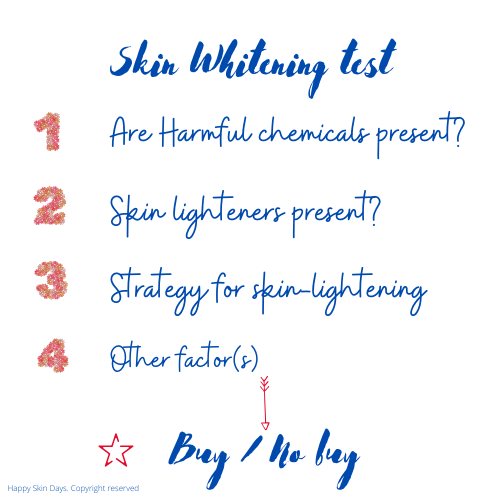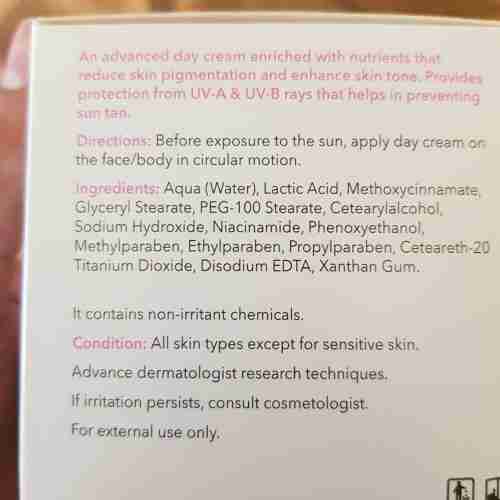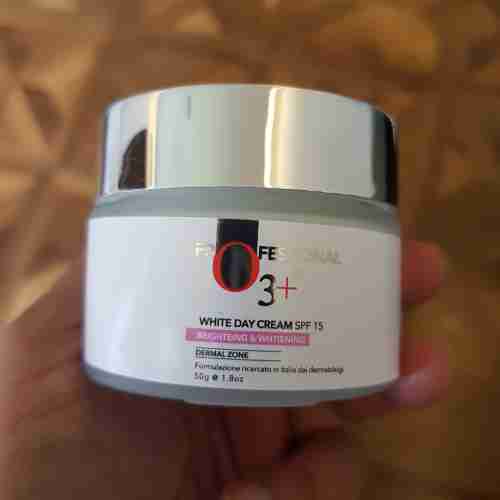This product has to be one of the cleverest products I have reviewed in a while. Find out why.
I will be applying this test

1) Are harmful chemicals present?
Yes – this product contains parabens (propyl – methyl- and ethyl-). Parabens – are cheap and effective preservatives that are endocrine system disruptors (estrogen mimickers). Other manufacturers manage to avoid parabens, so I don’t see why any manufacturer needs to use them (See also Chemicals to Avoid – Parabens).
I respect your prerogative to use product containing parabens. Please continue reading.
Q2) Are skin lighteners present? Q3) What is the product’s strategy for skin lightening?

Yes. There are two skin lightening ingredients: Lactic Acid and Niacinamide.
Lactic Acid
The second listed ingredient is Lactic Acid and as more of it is present, the product is relying principally on Lactic Acid to provide skin lightening.
Its benefits are:
- Moisturising: It has been used to ameliorate dry skin as Lactic Acid is a humectant – it helps the skin to hold water.
- Reduce photodamage: An 8% Lactic Acid formulation has been found to reduce the overall severity of photo-damaged skin, mottled hyper-pigmentation, sallowness, and skin roughness.
- Skin lightener: Lactic Acid reduces melanin synthesis by directly inhibiting the Tyrosinase enzyme, causing the skin to become lighter (see also: how is Melanin formed? for more details on the importance of Tyrosinase enzyme)
Lactic Acid is also an exfoliating acid, which
- Promote cellular turnover, exposing new, younger-looking, brighter, and more glowing skin. (This skin has simply not been exposed to the elements)
- Improve the effectiveness of topical skin treatments, which after the top layer of the skin is removed are able to penetrate the skin deeper.
Side effects of lactic acid
Despite Lactic Acid’s many benefits, it can still have irritating effects. E.g. redness, swelling, rash, post-inflammatory hyper-pigmentation.
Therefore, if you have generally have:
- Sensitive skin (including photo-sensitivity),
- Difficulties finding new products, because your skin reacts poorly
- Rosacea and so on, then you should give Lactic Acid a wide berth.
Similarly, if you have very dark skin then lactic acid may cause increased pigmentation. I have had experience of this when I was using a daily exfoliating acid as a toner.
Niacinamide
Melanin is the pigment that is primarily responsible for our skin colour (see also What gives our skin its colour?). Niacinamide reduces the amount of melanin being transferred to the epidermis (the topmost layer of our skin). By default, this means lighter skin.
BUT, for this to be possible the product needs to contain SUFFICIENT QUANTITIES OF Niacinamide. The label indicates Niacinamide is the 8th listed ingredient, which means its quantity is likely less than 1% of the formula. I don’t this is sufficient to provide meaningful skin lightening.
Q3) What is the product’s strategy for skin lightening?
One of the immediate body responses to over-exposure to UV radiation is that our body produces more melanin. More melanin results in tanning and darkening of skin complexion. The purpose of the sunscreen ingredients is to prevent this cascade of events caused by UVR exposure.
This day cream aims to do this by having a sunscreen filter, Octinoxate. It also has Titanium Dioxide – but I am not sure its a coloring agent or a filter.
Would I buy this product again?
I am not OK with the parabens, so that means I wouldn’t use this cream.
If you are OK with parabens, then definitely this will give you immediate skin lightening. Having lactic acid as the second ingredient means that newer, younger-looking, brighter, and more glowing skin is revealed every day.
BUT, if you have:
- Sensitive skin (including photo-sensitivity),
- Difficulties finding new products, because your skin reacts poorly
- Rosacea and so on, then you should give Lactic Acid a wide berth
- Dark skin that is prone to pigmentation
then gives this product a wide berth.
If you do plan use to use this product, please absolutely use a separate sunscreen product with at least an SPF 30. You cannot rely on the protection offered by this product.
****
COPYRIGHT
I wish to remind some of you that I am a non-affiliated skincare blogger. I invest my time, money, blood, sweat, and tears in creating content for my blog. My blog is read in multiple countries and according to my lawyer, each of those countries protects my content and rights under copyright law. If you would like to use my content, do the right thing, and write to me at email@happyskindays.com. Don’t be that person who steals content, because it’s arrogant, disrespectful, and ultimately, a crime.
